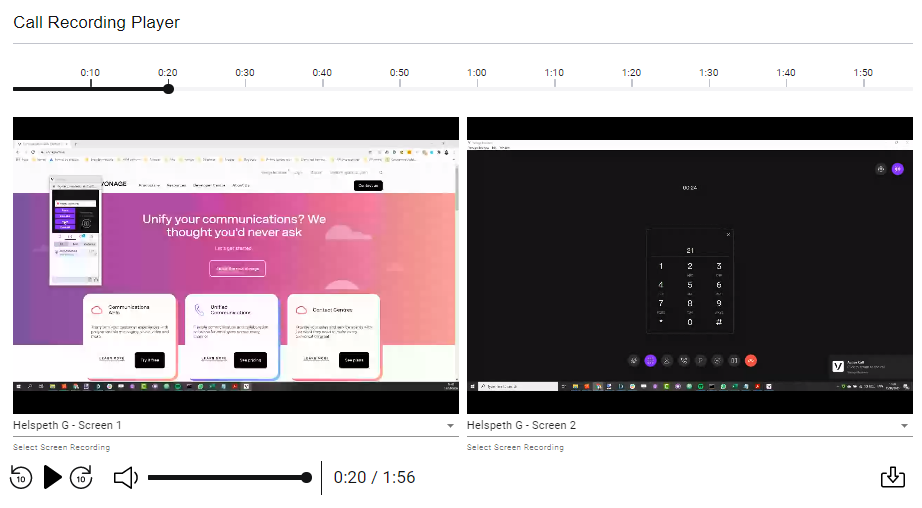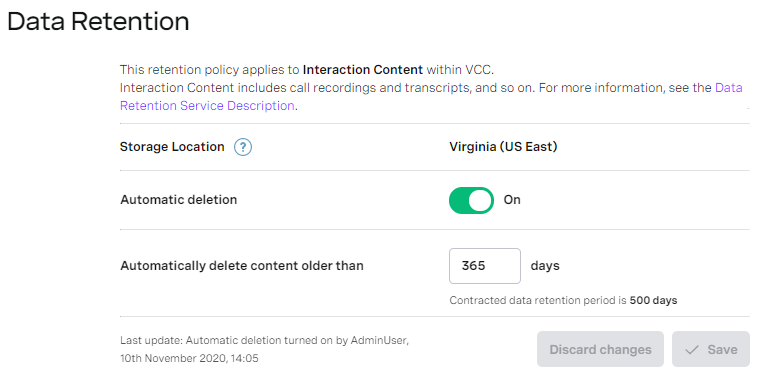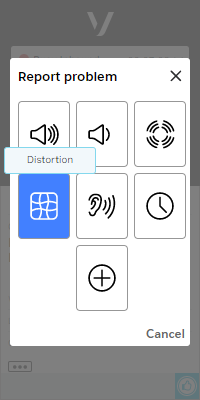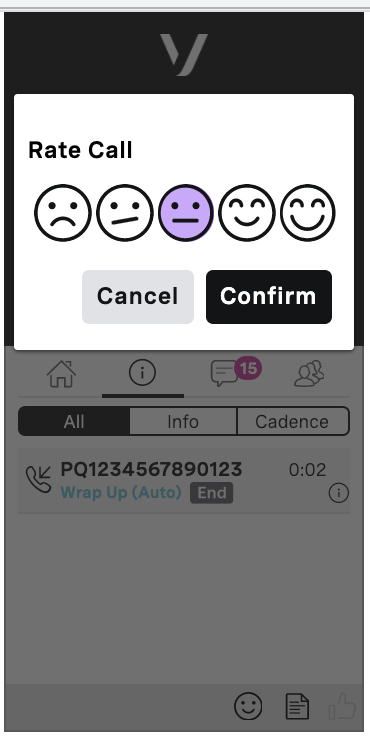...
In this page | ||||
|---|---|---|---|---|
|
![]() Platform-wide feature
Platform-wide feature
![]() Optional feature
Optional feature
General Availability Features
Visual Engagement (Video and Screen Share)
...
Consumers have consistently favored video for interactions where they want a personalized experience or have a complex problem they need resolved. Visual Engagement elevates conversations by enabling an agent, via a single click from within ContactPad, to escalate any interaction to a video call with screen share capabilities. This allows them to communicate visually, making them more effective and efficient, and resulting in a better customer experience.
Whilst engaged with a video call, the agent’s state and capacity will appear as occupied, informing their supervisor and other agents that they are on a call, whilst also updating the contact center routing so that no other interaction is routed through to them.
Visual Engagement is a native channel for Vonage Contact Center (VCC) and is made available to agents using ContactPad when embedded in Salesforce, Microsoft Dynamics or ServiceNow. Supervisors and business analysts will also be able to historically report on video interactions alongside voice and any other channel which the agent supports.
Visual Engagement will enable enables your business to achieve the following:
- Reduce time to resolution
- Make customers happier
- Lower cost to serve
- Increase first call resolution rates
- Engender trust
- Increase win rate
- Increase retention
- Protect revenue
- Communicate more effectively
- Compensate for travel cost and restrictions
- Save on travel expenses
- Reduce impact of travel restrictions
- Increase number of contact center channels
- Remain competitive in the market and keep up with evolving technology trends
- Fastest growing channel for customer service
- Report on visual engagement in real-time and historically
Visual Engagement will be is available on request. If you are interested, please speak to your Customer Success Manager or Account Manager.
...
For information about video and screen sharing, see Video and screen sharing (Visual Engagement).
Omnichannel 
Webchat
Up until now our Omnichannel capabilities have been a premium feature and required a Salesforce license. However we understand that not all our customers use Salesforce and furthermore not all our customers are looking for the full feature set of our premium license. Therefore we plan to offer an Omnichannel experience for all our customers regardless of which CRM or license they use.
...
This approach ensures that regardless of who provides your digital channels, Vonage can route them all harmoniously alongside voice. As we add channels to our offering, you get the choice over whether or not you want to adopt them out-of-the-box.
For In Spring ‘21 we are releasing released webchat as our first native channel. Webchat requests will be are routed straight from your website directly to the appropriately skilled agent via the ContactPad. This means an agent can work on various interaction types all in one place, as webchat will be is accessible directly from your CRM, whether you use Salesforce, Microsoft Dynamics or ServiceNow. All the context of your customer is readily available while your agent deals with their request, saving time and improving your agent’s efficiency.
Our webchat is provided as an alternative to our existing product in Salesforce, not as a replacement. We provide the flexibility for our customers to choose their channel provider and we will continue to offer a suite of off-the-shelf options in Salesforce, MS Dynamics and ServiceNow as well as providing APIs for third party integrations. All options will work in harmony with our own native channels, since the same routing logic is employed by all.
Webchat will be is available on request, so please contact your Customer Success Manager or Account Manager to learn more.
...
During Winter ‘21 we announced the beta release of Messaging and Cases. For In Spring ‘21 these features have moved into general availability. This enables VCC to route messages and cases to agents via using Salesforce External Routing. Messaging lets your company have conversations with customers in ways that are most convenient for them using messaging apps such as SMS and Facebook Messenger. Cases let your company capture work to be done using, among other methods, web-to-case and email-to-case. Agents will have messages and cases routed to them in the Service Console, based on the contact center routing logic, the agents skill, capacity, and availability.
Screen
...
Recording 
Screen Recording allows enables supervisors and quality managers to understand what the agents were doing on their desktops during the call and listen to the call. This improves your quality management capabilities so that you can easily identify inefficiencies.
Screen Recording will enable enables your business to achieve the following:
- Identify coaching opportunities to improve call efficiency
- Record one or two screens, not just browsers or applications
- Understand after call work activities
- Synchronize desktop activity with audio recordings
- Playback multiple screens at once
- Zoom into agents screens
- Download audio and video in a single file
- Identify which calls have just audio and transcription and screen recordings easily
- Store screen recordings securely
- Set permissions on who can view screen recordings
- Centrally control whose screens are recorded
- Link screen recordings to Conversation Analyzer
...
For more information about screen recording, see ContactPad with Screen Recording.
Virtual Assistant 
Virtual Assistant delivers conversational artificial intelligence (AI) for business communication within your Vonage solution, making customer experience your competitive advantage. Virtual Assistant uses AI to deliver enhanced self-service interactions that engage every caller with natural language and enable additional capacity within your contact center.
...
This release provides a more intuitive version of the intent builder by using a visual builder to represent your conversations more clearly.
User
...
Administration 
In this release we are taking took the next step to consolidate in consolidating all administrative functions into User Admin. Functionality previously available only in Real Time and User Access have been migrated over to User Admin.
...
Supervisors with the appropriate permissions can now take advantage of the full User Admin Experience. This provides full parity with Real Time and much more.
User Admin willnow:
- Allow Allows supervisors to edit users, groups and skills in which they have permission
- Respect Respects a supervisor’s group permissions when providing view or edit access to a user
- Respect Respects a supervisor’s managers when providing view or edit access to other supervisors
...
All users that previously had the “Edit Agent” Edit Agent permission under Real Time have been given the “Edit User” permission Edit User permission under User Admin.
Archive Users
Previously only available as early access. All customers can now archive all user types at an individual level or via bulk/import. This will prevent Archiving a user prevents them from logging in, release their license, and remove them from Dashboards. All this whilst providing the ability to historically report on these users.
This has resulted in the following changes within the CSV import/export:
- "User Active" has been added
- “Active" Active changed name to "ContactPad enabled"
Unlock User Account
The ability to reset login attempts has been migrated from Real Time into User Admin. This is used to unlock and user account when it has become locked because of a high number of incorrect password attempts.
...
We have been working to improve the user experience or User Admin by making filtering more effective, providing quick bulk actions, improved layout, and much more.
Dashboards (platform-wide feature)
Dashboards have For more information about user administration, see User Admin.
Dashboards 
Dashboards have been extended to provide greater visibility for outbound-focused contact centers. In addition, terminology and calculations have been updated to be channel agnostic (phone, chat, video, and so on). Finally we have added some new in-demand metrics across the Agents and Interaction Details widgets.
...
The Agent Widget has been extended to provide greater insight into the running of a Contact Centercontact center. The following new metrics have been added:
...
- Not Answered renamed to Agent No Answer: The number of interactions that the agent rejected or missed. Agent No Answer is a subset of Unexpected.
- Number Busy renamed to Agent Number Busy: The number of calls that the agent did not answer because their line was busy. Agent Number Busy is a subset of Unexpected.
- Answered renamed to Accepted: The sum of Accepted Inbound, Accepted Internal or Accepted Outbound
- Avg. Handle Time calculation update: The average time the agent spent handling interactions, which is the average of the sum of Alerting Time, Connected Time and Wrap Time: excluding Parked (non-live Hold) and Interrupted time.
- Avg Ringing Time renamed to Avg Alerting Time: No change.
- Failed renamed to Failed to Connect: The number of interactions that failed to connect to an agent possibly due to configuration or network errors.
- Interaction State - Failed renamed to Interaction State - Failed to Connect: No change.
- Interaction State - No Answer renamed to Interaction State - Agent No Answer: No change.
- Interaction State - Number Busy renamed to Interaction State - Agent Number Busy: No change.
- Interaction State - Ringing renamed to Interaction State - Alerting: No change.
- Offered calculation update - The sum of Offered Internal, Offered Inbound, and Offered Outbound.
- Significant Interactions calculation update: The number of interactions that were connected to more than one party (agent plus another) for longer than the configured threshold. For example, the number of calls where the agent was connected to the customer for at least 1 minute. Significant Interactions can be used to filter out voicemail and short, insignificant conversations.
- Max Handle Time calculation update: The longest time any interaction was handled by an agent, which is the longest of the sum of Alerting Time, Connected Time and Wrap Time: excluding Parked (non-live Hold) and Interrupted time.
- Min Handle Time calculation update: The shortest time any interaction was handled by an agent, which is the shortest of the sums of Alerting Time, Connected Time and Wrap Time: excluding Parked (non-live Hold) and Interrupted time.
- Total Talk Time calculation update: The total time that any party spent on hold (live interactions), or the interaction was parked (non-live interactions). If multiple hold events coincide for multiple parties then elapsed time is reported.
For more information about metrics available in Dashboards, see Dashboard metrics.
Web
...
APIs 
We continue to make the VCC platform more open to integration than ever before.
...
Any new API Credentials generated within "API Admin" will now be attached to the user generating them. In addition, should that user be marked as inactive or deleted, then those API credentials will cease working.Important:
| Note | ||
|---|---|---|
| ||
| Many of our APIs still operate at account levels—meaning that even with user-level credentials, the APIs will grant Admin privileges. We are now beginning to migrate all APIs to enforce user permissions. |
The first API to be migrated is the Interaction Content API. API requests made to this API will now can only be able to access the data the same user could through the application. This allows customers to provide programmable access to a subset of their dataset.
...
For a migration guide from the existing version, or to review these features in detail visit Interaction Content API Documentation.
Target Time-to-Answer Metrics for Virtual
...
Queues 
Within VCC a collection of skills can be grouped into a Virtual Queue. This virtual queue can then be used to optimize route, or for reporting. In this release we have extended the reporting capability into the Insights Stats API as part of the interaction endpoints. This provided the user with a "targetTimeToAnswer" metric for each virtual queue within a queue event.
...
This time can be used in conjunction with the result and duration properties to calculate Service Levels in an external system.
Platform
Delete Interaction Content in
...
Bulk 
As part of this release users will be are able to delete the Interaction Content—including Call Recording—for up to 1000 interactions in bulk. This functionality is available within the Interaction Search component of the VCC portal.
...
For information about deleting interaction content in bulk, see Deleting interaction content.
Alternative Content Storage Locations 
Within each region we operate, Interaction Content—including Call Recordings—has previously been stored in one core location, as detailed below:
...
You can see where your data is stored now within the Data Retention Portal menuarea of VCC:
To adjust your storage location, contact the Vonage support team. A change in location is only respected for future Interaction Content.
For information about data retention, see Data Retention.
Agent
...
Experience 
Report Audio Problems
The Spring ‘20 release included a major update to the button that agents can use to report audio quality problems during a call. This was of particular benefit for inbound calls.
The Spring ‘21 release includes improved support for outbound calls in Dashboards, which means you can now get the same benefits for outbound calls.
Vonage Contact Center users VCC users can now:
- Specify the type of problem being experienced, e.g. too loud, too quiet, echo, distortion, background noise, delay, or other (the button can be used multiple times in a single call)
- View reports of audio problems for inbound and outbound calls in Dashboards
- Retrieve the audio problems reports through an API
This feature was enabled on request in Spring ‘20 and will roll out to everyone by default in this release.
For information about reporting audio problems in ContactPad, see Reporting audio problems.
Post Call Quality Rating
To truly understand your Contact Center contact center you need to know when things are going well in addition to when they’re going wrong. In Spring ‘20, the Report Audio Problems feature was added to VCC and Post Call Quality Rating was added in Summer ‘20.
...
This feature was enabled on request in Summer ‘20 and will roll rolled out to everyone by default in this release.
For information about Post Call Quality Rating, see Post Call Quality Rating.
Release Behavior
When an agent is in a ready state, the platform will automatically deliver any eligible interactions. If the agent is not ready for an interaction, the agent may click the release button in ContactPad rather than allow the call to ring out. Clicking “release” Release in ContactPad will always terminate the call—whereas WebRTC users clicking the “decline” button Decline during the ringing phase will route the call back to the queue.
...
the call back to the queue.
For information about rejecting a call in ContactPad, see How do I reject an incoming call? in Working with an inbound call.
Cadence 
Overview - Now Generally Available for Voice
...
- Ensure data driven follow ups
- Improve CSAT
- Increase customer loyalty
- Encourage upsell
- Reduce churn
- Deliver on Service Level Agreements
- Optimize agent utilization
For information about Cadence, see Cadence.
Beta/Early Access Program
...
If you are interested in gaining access to a feature in the Beta/Early Access Program, please contact your Customer Success Manager or Account Manager. Participation in this pilot program is at the discretion of Product Management and not guaranteed.
Enabling the Salesforce Service Cloud Voice “Bring Your Own Telephony”
...
Pilot 
According to Salesforce, Service Cloud Voice unifies phone, digital channels, and CRM data in real-time in one centralized console. This is the contact center of the future—intelligent, unified, and fast. Now companies can:
...
For example, when a customer calls in, the Vonage transcription capabilities turn speech into text that can be viewed alongside customer data in the console. This empowers the agent to deliver a personalized experience based on factors like the customer’s purchase history, warranty information, or past
interactions across channels. With the call converted to text, Einstein AI can go to work by serving up recommended responses, knowledge articles, and next best actions to the agent.
Vonage Contact Center VCC now enables Salesforce to deliver these benefits through the power of our Interaction Architect, Salesforce integration, and audio quality. These are key areas to a successful deployment of Service Cloud Voice.
To use Service Cloud Voice, it is possible to continue with existing call flows, users, and contact numbers—though items like case pops may need to be changed. A review of your Vonage Contact Center implementation VCC implementation is recommended to understand what changes need to be made, if any, to take advantage of Service Cloud Voice.
It is important to understand that the existing integration between Salesforce and Vonage Contact Center does VCC does not change and will continue to provide the existing benefits. Service Cloud Voice just provides a possible alternative to how you want Salesforce and Vonage Contact Center to VCC to work together
to provide benefit to your contact center.
Note that adding this service may incur professional services time and additional product charges. If you would like to be considered for the Beta/Early Access Program, please discuss it with your Customer Success Manager or Account Executive. Participation in the pilot program is at the discretion of Product Management and not guaranteed.
Analytics Dashboards - North America Only (Beta)
...
Historic reporting within a Contact Center is contact center is a key pillar of success. The new Analytics offering will bring the power of a Business Intelligent system into the VCC Portal for customers of all types. This offers the ability to:
...
The interaction plans you are able to configure within Vonage Contact Center VCC can be incredibly powerful. You’re able to integrate with your third-party applications such as backend databases or your CRM which can help route, prioritize, and skill interactions as we learn more about the consumer. This can enable the implementation of a self-serve IVR or simply remove the painful chain of menus for a more personalized experience—and make sure your consumers speak with the right people, in the right order.
The problem today is that once the interaction has finished, all of this processing stops. With the Spring ’21 release, Vonage Contact Center will enable VCC enables you to initiate a fresh interaction plan after the processing of an interaction has finished. The caller doesn’t need to hang around for this, as you will be able to
conditionally evaluate the outcome of the previous interaction to determine what, if anything, you decide to do next.
...
With this release, the VCC Status Page names will be have been updated as detailed below:
...
In addition the VCC Uptime Page, names will be have been updated as detailed below:
...
The following packages and earlier versions will be have been deprecated:
Package | Supported Versions | Deprecated Versions | End of Life |
|---|---|---|---|
Vonage Contact Center for Salesforce | 18.251 or higher | 18.250 or lower | 18.231 or lower |
Vonage Contact Center Connect | 19.100 or higher | 18.259 or lower | 16.118.1 or lower |
Vonage Contact Center Advanced Reporting | 2.47 57 or higher | 2.56 or lower | 2.44 or lower |
...



